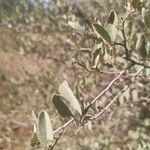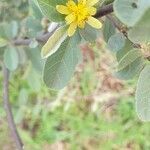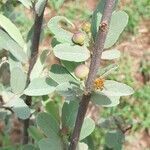A shrub which loses its leaves during the year. It is spreading, branched and twiggy. It can grow up to 4 m tall. Young branches are grey and hairy. The leaves are pale green and rough. They are 1.3-8 cm long and 2.5 cm wide. The tips are rounded and the base is narrowed. The base is unequal sided. The edges have fine teeth. The flowers are small and star shaped. They have narrow yellow petals. They are usually produced singly in the axils of leaves. The fruit have 1 or 2 lobes. They are hairy and red when ripe. They are edible.
Leaf-lamina 1·4–7 × 0·75 — 2·5 cm., elliptic or oblanceolate, rounded at the apex, margin finely serrulate to dentate, cuneate and equal-sided at the base, very finely and closely tomentellous above, somewhat paler and more densely tomentellous below, venation fairly prominent and reticulate; petiole c. 2 mm. long, tomentellous; stipules c. 5 mm. long, subulate, tomentellous.
Compact shrub, ± 2 m high. Branchlets greyish tomentose. Leaves with blade elliptic or narrowly obovate, 14-70 x 7.5-25 mm, base cuneate, symmetrical, margins finely serrulate, nerves raised and reticulate on densely tomentellous lower surface. Flowers: axillary; sepals ± 8 mm long; petals shorter than sepals, yellow; Aug.-May. Fruit globose or bilobed-globose.
Inflorescences all axillary; peduncles 7·5–10 mm. long, tomentellous; pedicels normally 1 per peduncle, up to 1 cm. long, tomentellous; basal bracts 3–4 mm. long, very caducous, subulate, tomentellous.
Ovary villous, shallowly 2-lobed or 1-lobed by abortion when the style is eccentrically placed on the ovary; style c. 4 mm. long, glabrous, with flattened, broad, stigma-lobes.
Petals yellow, c. 2/3 the length of the sepals, linear-oblong to oblanceolate, with a basal nectariferous claw circumvillous within ledged above and sparsely pilose outside.
Sepals c. 8 mm. long, linear-lanceolate to linear-oblong, greenish-grey-tomentellous without, yellow and glabrous within, 3-nerved.
Compact shrub c. 2 m. tall; young branchlets greyish or greyish-brown, tomentellous; older branches dark purplish-black.
Compact shrub, 2 m high. Leaves symmetrical at base, nerves raised and reticulate below. Flowers yellow.
Fruit reddish when ripe, c. 8 mm. in diam., globose or 2-lobed, sparsely setulose, glabrescent.
Androgynophore c. 1 mm. tall, glabrous except at the apex, not extended above the node.
Flower-buds obovoid, slightly sulcate.




